Livestock Animal Displacement on Rural Tourism Destinations: Placing Livestock's “Pest” Role in the Background
Abstract
:1. Introduction
2. Theoretical and Methodological Background
2.1. Animal Placement Theory
2.2. Animal-Tourism Relationships
2.3. The Actor-Network Theory (ANT)
2.4. ANT in Animal Placement Research
2.5. ANT in Tourism Research
3. Research Preparation
3.1. Research Area
3.2. Research Design
3.3. Fieldwork and Research Hypothesis
3.3.1. What Is the Livestock Displacement?
3.3.2. Who Are the Actors, What Do They Do?
3.4. Data Collection and Sample Representativeness
4. Results: How to Establish the Actor-Networks?
4.1. The Effective Actions
4.2. The Critical Paths
4.3. The Processes of Translation
4.3.1. Problematization
4.3.2. Interest and Enrollment
4.3.3. Mobilization and Opposition
5. Conclusions and Discussion
5.1. Conclusions
5.2. Discussion
Acknowledgments
Author Contributions
Conflicts of Interest
References
- Wilkie, R. Sentient commodities and productive paradoxes: The ambiguous nature of human–livestock relations in Northeast Scotland. J. Rural Stud. 2005, 21, 213–230. [Google Scholar] [CrossRef]
- Diamond, J. Evolution, consequences and future of plant and animal domestication. Nature 2002, 418, 700–707. [Google Scholar] [CrossRef] [PubMed]
- Vilà, C. Multiple and Ancient Origins of the Domestic Dog. Science 1997, 276, 1687–1689. [Google Scholar] [CrossRef] [PubMed]
- Chen, Z.W. Kaleidoscope the Ancient World; Flower City Press: Guangzhou, China, 1985; p. 107. (In Chinese) [Google Scholar]
- Buye, H. World Dwelling; China Building Industry Press: Beijing, China, 2011. (In Chinese) [Google Scholar]
- Muresan, I.C.; Oroian, C.F.; Harun, R.; Arion, F.H.; Porutiu, A.; Chiciudean, G.O.; Lile, R. Local Residents? Attitude toward Sustainable Rural Tourism Development. Sustainability 2016, 2, 100. [Google Scholar] [CrossRef]
- Quaranta, G.; Citro, E.; Salvia, R. Economic and Social Sustainable Synergies to Promote Innovations in Rural Tourism and Local Development. Sustainability 2016, 7, 668. [Google Scholar] [CrossRef]
- Trukhachev, A. Methodology for Evaluating the Rural Tourism Potentials: A Tool to Ensure Sustainable Development of Rural Settlements. Sustainability 2015, 3, 3052–3070. [Google Scholar] [CrossRef]
- Andrei, D.R.; Gogonea, R.M.; Zaharia, M.; Andrei, J.V. Is Romanian Rural Tourism Sustainable? Revealing Particularities. Sustainability 2014, 12, 8876–8888. [Google Scholar] [CrossRef]
- Evans, N.; Yarwood, R. Livestock and landscape. Landsc. Res. 1995, 20, 141–146. [Google Scholar] [CrossRef]
- Holloway, L. Pets and protein: Placing domestic livestock on hobby-farms in England and Wales. J. Rural Stud. 2001, 17, 293–307. [Google Scholar] [CrossRef]
- Holloway, L. What a Thing, then, is this Cow…: Positioning Domestic Livestock Animals in the Texts and Practices of Small-Scale “Self-Sufficiency”. Soc. Anim. 2003, 11, 145–165. [Google Scholar] [CrossRef]
- Yarwood, R.; Evans, N. New Places for “Old Spots”: The Changing Geographies of Domestic Livestock Animals. Soc. Anim. 1998, 6, 137–165. [Google Scholar] [CrossRef]
- Yarwood, R.; Evans, N. The changing geography of rare livestock breeds in Britain. Geography 1999, 84, 80–87. [Google Scholar]
- Yarwood, R.; Evans, N. Livestock, locality and landscape: EU regulations and the new geography of Welsh farm animals. Appl. Geogr. 2003, 23, 137–157. [Google Scholar] [CrossRef]
- Holloway, L. Subjecting cows to robots: Farming technologies and the making of animal subjects. Environ. Plan. D Soc. Space 2007, 25, 1041–1060. [Google Scholar] [CrossRef]
- MacLachlan, L. Book Review: Animal spaces, beastly places: New geographies of human-animal relations. Pro. Hum. Geogr. 2002, 26, 426–427. [Google Scholar] [CrossRef]
- Hicks, J.R. Book Review: Tourism and animal ethics. J. Tour. Cult. Chang. 2013, 11, 223–225. [Google Scholar] [CrossRef]
- Rozman, Č.; Potočni, M.; Paže, K.; Bore, A.; Majkovi, D.; Bohanec, M. A multi-criteria assessment of tourist farm service quality. Tour. Manag. 2009, 30, 629–637. [Google Scholar] [CrossRef]
- Fennell, D.A. Tourism, Animals and Utilitarianism. Tour. Recreat. Res. 2012, 37, 239–249. [Google Scholar] [CrossRef]
- Shani, A. Tourism and Animal Rights: More than Meets the Eye. Tour. Recreat. Res. 2012, 37, 276–277. [Google Scholar] [CrossRef]
- Fennell, D.A. Tourism and Animal Welfare. Tour. Recreat. Res. 2013, 38, 325–340. [Google Scholar] [CrossRef]
- Yudina, O.; Fennell, D. Ecofeminism in the Tourism Context: A Discussion of the Use of Other-than-human Animals as Food in Tourism. Tour. Recreat. Res. 2013, 38, 55–69. [Google Scholar] [CrossRef]
- Moran, D. Budgie smuggling or doing bird? Human-animal interactions in carceral space: Prison(er) animals as abject and subject. Soc. Cult. Geogr. 2015, 16, 634–653. [Google Scholar] [CrossRef]
- Bruford, M.W.; Bradley, D.G.; Luikart, G. DNA markers reveal the complexity of livestock domestication. Nat. Rev. Genet. 2003, 4, 900–910. [Google Scholar] [CrossRef] [PubMed]
- Zeder, M.A.; Emshwiller, E.; Smith, B.D.; Bradley, D.G. Documenting domestication: The intersection of genetics and archaeology. Trends Genet. 2006, 22, 139–155. [Google Scholar] [CrossRef] [PubMed]
- Bear, C.; Eden, S. Making space for fish: The regional, network and fluid spaces of fisheries certification. Soc. Cult. Geogr. 2008, 9, 487–504. [Google Scholar]
- Nelson, K.B. Enhancing the Attendee’s Experience through Creative Design of the Event Environment: Applying Goffman’s Dramaturgical Perspective. J. Conv. Event Tour. 2009, 10, 120–133. [Google Scholar] [CrossRef]
- Philo, C.; Wilbert, C. (Eds.) Animal Spaces, Beastly Places: New Geographies of Human-Animal Relations; Routledge: London, UK, 2000. [Google Scholar]
- Johnston, C.L. Geography, Science, and Subjectivity: Farm Animal Welfare in the United States and Europe. Geogr. Compass 2013, 7, 139–148. [Google Scholar] [CrossRef]
- Johnston, C. Beyond the clearing: Towards a dwelt animal geography. Prog. Hum. Geogr. 2008, 32, 633–649. [Google Scholar] [CrossRef]
- Urbanik, J. Placing Animals: An Introduction to the Geography of Hum.-Animal Relations; Rowman and Littlefield Publishers, Inc.: Lanham, MD, USA, 2012. [Google Scholar]
- Buller, H. Individuation, the Mass and Farm Animals. Theory Cult. Soc. 2013, 30, 155–175. [Google Scholar] [CrossRef]
- Buller, H. Animal geographies III: Ethics. Prog. Hum. Geogr. 2015, 40, 308–318. [Google Scholar] [CrossRef] [Green Version]
- Ingold, T. Epilogue: Towards a politics of dwelling. Conserv. Soc. 2005, 3, 501–508. [Google Scholar]
- Barua, M. Bio-Geo-Graphy: Landscape, dwelling, and the political ecology of human–elephant relations. Environ. Plan. D Soc. Space 2014, 32, 915–934. [Google Scholar] [CrossRef]
- Ballantyne, R.; Packer, J.; Sutherland, L.A. Visitors’ memories of wildlife tourism: Implications for the design of powerful interpretive experiences. Tour. Manag. 2011, 32, 770–779. [Google Scholar] [CrossRef] [Green Version]
- Hughes, P. Animals, Values and Tourism-Structural Shifts in UK Dolphin Tourism Provision. Tour. Manag. 2001, 22, 321–329. [Google Scholar] [CrossRef]
- Muboko, N.; Gandiwa, E.; Muposhi, V.; Tarakini, T. Illegal hunting and protected areas: Tourist perceptions on wild animal poisoning in Hwange National Park, Zimbabwe. Tour. Manag. 2016, 52, 170–172. [Google Scholar] [CrossRef]
- Lee, D.J.; Kruger, S.; Whang, M.J.; Uysal, M.; Sirgy, M.J. Validating a customer well-being index related to natural wildlife tourism. Tour. Manag. 2014, 45, 171–180. [Google Scholar] [CrossRef]
- Reynolds, P.C.; Braithwaite, D. Towards a conceptual framework for wildlife tourism. Tour. Manag. 2001, 22, 31–42. [Google Scholar] [CrossRef]
- Petroman, I.; Marin, C.; Buzatu, C.; Dumitrescu, A.; Coman, Ş.; Stan, A.; Avramescu, D. Solutions for Destination Management on Agri-Tourism Farm. Anim. Sci. Biotechnol. 2012, 45, 456–459. [Google Scholar]
- Agoramoorthy, G.; Harrison, B. Ethics and animal welfare evaluations in South East Asian zoos: A case study of Thailand. J. Appl. Anim. Welf. Sci. 2002, 5, 1–13. [Google Scholar] [CrossRef] [PubMed]
- Fennell, D.A. Tourism and Applied Ethics. Tour. Recreat. Res. 2000, 25, 59–69. [Google Scholar] [CrossRef]
- Ong, C. ‘Cuteifying’ spaces and staging marine animals for Chinese middle-class consumption. Tour. Geogr. 2017, 19, 188–207. [Google Scholar] [CrossRef]
- Mason, P. Zoo Tourism: The Need for More Research. J. Sustain. Tour. 2000, 8, 333–339. [Google Scholar] [CrossRef]
- Wijeratne, A.J.C.; Van Dijk, P.A.; Kirk-Brown, A.; Frost, L. Rules of engagement: The role of emotional display rules in delivering conservation interpretation in a zoo-based tourism context. Tour. Manag. 2014, 42, 149–156. [Google Scholar] [CrossRef]
- Aspling, F.; Juhlin, O. Theorizing animal–computer interaction as machinations. Int. J. Hum.-Comput. Stud. 2017, 98, 135–149. [Google Scholar] [CrossRef]
- Murphy, M.A. Framing built environment change through materials, agency and influence. Urban For. Urban Green. 2016, 17, 1–10. [Google Scholar] [CrossRef]
- Latour, B. Reassembling the Social: An Introduction to Actor Network Theory; Oxford University Press: Oxford, UK, 2005; p. 245. [Google Scholar]
- Wu, Y.; Liu, Y.X.; Chen, J.J.; Wang, Y.O. Following actors and reassembling the social: On Latour’s “Reassembling the social: An introduction to actor-network-theory”. Social Science. Study. 2008, 2, 218–234. (In Chinese) [Google Scholar]
- Johnston, J. Mixing Humans and Nonhumans Together: The Sociology of a Door-Closer. Soc. Probl. 1988, 35, 298–310. [Google Scholar] [CrossRef]
- Rodger, K.; Moore, S.A.; Newsome, D. Wildlife tourism, science and actor network theory. Ann. Tour. Res. 2009, 36, 645–666. [Google Scholar] [CrossRef]
- Law, J.; Hassard, J. Actor Network Theory and After Mass; Blackwell Publishing: Hoboken, NJ, USA, 1999; p. 17. [Google Scholar]
- Zhu, F.; Bao, J.G.; Xiang, Y.X. Actor-network-theory (ANT) and Paradigm Innovation for Tourism Research. Tour. Trib. 2012, 27, 24–31. (In Chinese) [Google Scholar]
- Callon, M. The Sociology of an Actor-Network: The Case of the Electric Vehicle. In Mapping the Dynamics of Science and Technology; Callon, M., Law, J., Rip, A., Eds.; Macmillan Press: Basingstoke, UK, 1986; pp. 19–34. [Google Scholar]
- Ai, S.W.; Miao, C.H. Philosophical thinking of economic geography: An actor-network-theory perspective. Econ. Geogr. 2009, 29, 545–550. [Google Scholar]
- Buller, H. Animal geographies II: Methods. Prog. Hum. Geogr. 2014, 39, 374–384. [Google Scholar] [CrossRef]
- Emel, J.; Wilbert, C.; Wolch, J. Animal geographies. Soc. Anim. 2002, 10, 407–412. [Google Scholar]
- Jones, O. The restraint of beasts: Rurality, animality, actor network theory and dwelling. In Country Visions; Cloke, P., Ed.; Pearson Education: London, UK, 2003; pp. 450–487. [Google Scholar]
- Risan, L.C. The boundary of animality. Environ. Plan D Soc. Space 2005, 23, 787–793. [Google Scholar] [CrossRef]
- Beard, L.; Scarles, C.; Tribe, J. Mess and method: Using ANT in tourism research. Ann. Tour. Res. 2016, 60, 97–110. [Google Scholar] [CrossRef]
- Van der Duim, R.; Ren, C.; Jóhannesson, G.T. (Eds.) Actor-Network Theory and Tourism: Ordering, Materiality and Bmultiplicity; Routledge: Abingdon, UK, 2012. [Google Scholar]
- Jóhannesson, G.T.; Ren, C.; van der Duim, R. (Eds.) Tourism Encounters and Controversies: Ongoing Politics of Tourism Development; Ashgate Publishing Ltd.: Farnham, UK, 2015. [Google Scholar]
- Van der Duim, R. Tourismscapes an actor-network perspective. Ann. Tour. Res. 2007, 34, 961–976. [Google Scholar] [CrossRef]
- Arnaboldi, M.; Spiller, N. Actor-network theory and stakeholder collaboration: The case of Cultural Districts. Tour. Manag. 2011, 32, 641–654. [Google Scholar] [CrossRef]
- Ren, C.; Pritchard, A.; Morgan, N. Constructing tourism research: A critical enquiry. Ann. Tour. Res. 2010, 37, 885–905. [Google Scholar] [CrossRef]
- Tribe, J. Tribes, territories and networks in the tourism academy. Ann. Tour. Res. 2010, 37, 7–33. [Google Scholar] [CrossRef] [Green Version]
- Jóhannesson, G.T. Emergent vikings: The social ordering of tourism innovation. Event Manag. 2007, 14, 261–274. [Google Scholar] [CrossRef]
- Jóhannesson, G.T. “To Get Things Done”: A relational approach to entrepreneurship. Scand. J. Hosp. Manag. Tour. 2012, 12, 181–196. [Google Scholar] [CrossRef]
- Paget, E.; Dimanche, F.; Mounet, J.P. A tourism innovation case: An actor-network approach. Ann. Tour. Res. 2010, 37, 828–847. [Google Scholar] [CrossRef]
- Povilanskas, R.; Armaitiene, A. Seaside resort-hinterland Nexus: Palanga, Lithuania. Ann. Tour. Res. 2011, 38, 1156–1177. [Google Scholar] [CrossRef]
- Ren, C. Nonhuman agency, radical ontology, and tourism realities. Ann. Tour. Res. 2011, 38, 858–881. [Google Scholar] [CrossRef]
- Hummel, J.; van der Duim, R. Tourism and development at work: 15 years of tourism and poverty reduction within the SNV Netherlands Development Organisation. J. Sustain. Tour. 2012, 20, 319–338. [Google Scholar] [CrossRef]
- Van der Duim, R.; Caalders, J. Tourism chains and pro-poor tourism development: An actor-network analysis of a pilot project in Costa Rica. Curr. Issues Tour. 2008, 11, 109–125. [Google Scholar] [CrossRef]
- Wearing, S.; Wearing, M.; McDonald, M. Understanding local power and interactional processes in sustainable tourism: Exploring village-tour operator relations on the Kokoda track, Papua New Guinea. J. Sustain. Tour. 2010, 18, 61–76. [Google Scholar] [CrossRef]
- Le Velly, R.; Dufeu, I. Alternative food networks as “market agencements”: Exploring their multiple hybridities. J. Rural Stud. 2016, 43, 173–182. [Google Scholar] [CrossRef]
- Tang, G.; Zhang, J.; Sun, J.; Peng, H.; Zhang, Y. Construction of residential landscape in tourism destination morphology evolution of tourism localization: A case study of the Hani mushroom houses based on local oral history. Trop. Geogr. 2016, 36, 556–563. (In Chinese) [Google Scholar]
- Wang, Q.H. Terraced Culture—Hani Ecological Agriculture; Yunnan University Press: Kunming, China, 1999. (In Chinese) [Google Scholar]
- Huang, S.H.W.; Liao, G.Q. The Traditional Eco-Culture Studies on the Yunnan Hani People; China Social Sciences Press: Beijing, China, 2008. (In Chinese) [Google Scholar]
- Luo, D.Y.; Sun, N.; Huo, X.W.; Gao, X. Hani Terraced Village; China Building Industry Press: Beijing, China, 2013; pp. 87–170. (In Chinese) [Google Scholar]
- Babbie, E. The Practice of Social Research; Tsinghua University Press: Beijing, China, 2007; p. 189. (In Chinese) [Google Scholar]
- Feng, X.T. Modern Social Survey Methods; Huazhong University of Science and Technology Press: Wuhan, China, 2009; pp. 66–67. (In Chinese) [Google Scholar]
- Geng, X.L. Social Survey Sample Size Determination; Science Press: Beijing, China, 2008; p. 203. (In Chinese) [Google Scholar]
- Agresti, A. Categorical Data Analysis; Qi, Y.Q., Translator; Chongqing University Press: Chongqing, China, 2012; p. 119. (In Chinese) [Google Scholar]
- Menard, S. Applied Logistic Regression Analysis; SAGE Publications, Inc.: Thoussand Oaks, CA, USA, 1995; p. 90. [Google Scholar]
- Wang, J.C.; Guo, Z.G. Logistic Regression Models and Application; Higher Education Press: Beijing, China, 2001; pp. 191–193. (In Chinese) [Google Scholar]
- Wu, M.L. Structural Equation Model: AMOS Operation and Application; Chongqing University Press: Chongqing, China, 2009; p. 271. (In Chinese) [Google Scholar]
- Liu, X.; Wang, X. A review on the application of actor network theory to human geography. Prog. Geogr. 2013, 32, 1139–1147. (In Chinese) [Google Scholar]
- Law, J. Notes on the theory of the actor network: Ordering, strategy and heterogeneity. Syst. Pract. Action Res. 1992, 5, 379–393. [Google Scholar] [CrossRef]
- Latour, B. On interobjectivity. Mind Cult. Act. 1996, 3, 228–245. [Google Scholar] [CrossRef]
- Taylor, P.J.; Walker, D.R.F. World cities: A first multivariate analysis of their service complexes. Urban Stud. 2001, 38, 23–47. [Google Scholar] [CrossRef]
- Yeung, H.W.C. Theorizing economic geographies of Asia. Econ. Geogr. 2003, 79, 107–128. [Google Scholar] [CrossRef]
- Markusen, A. Fuzzy concepts, scanty evidence and policy distance: The case for rigour and policy relevance in critical regional studies. Reg. Stud. 1999, 33, 869–886. [Google Scholar] [CrossRef]
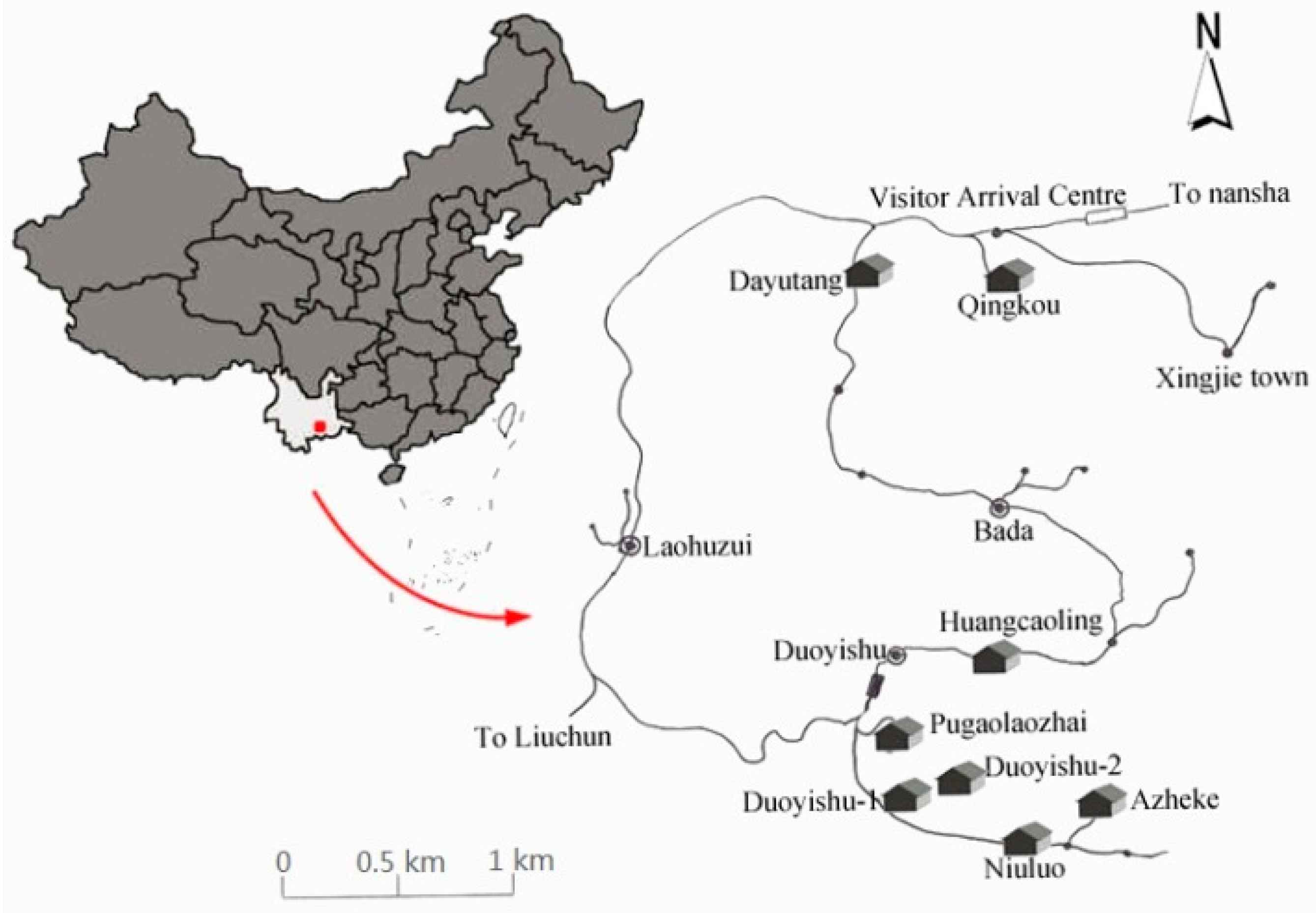
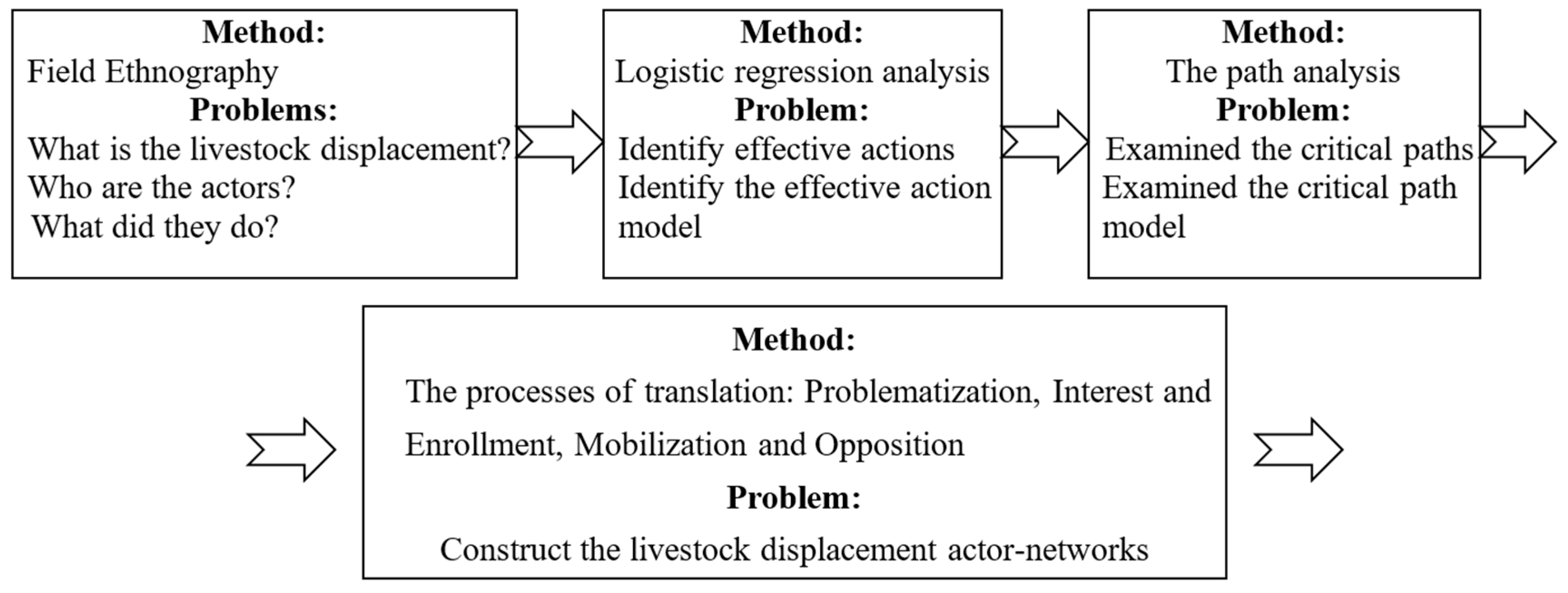
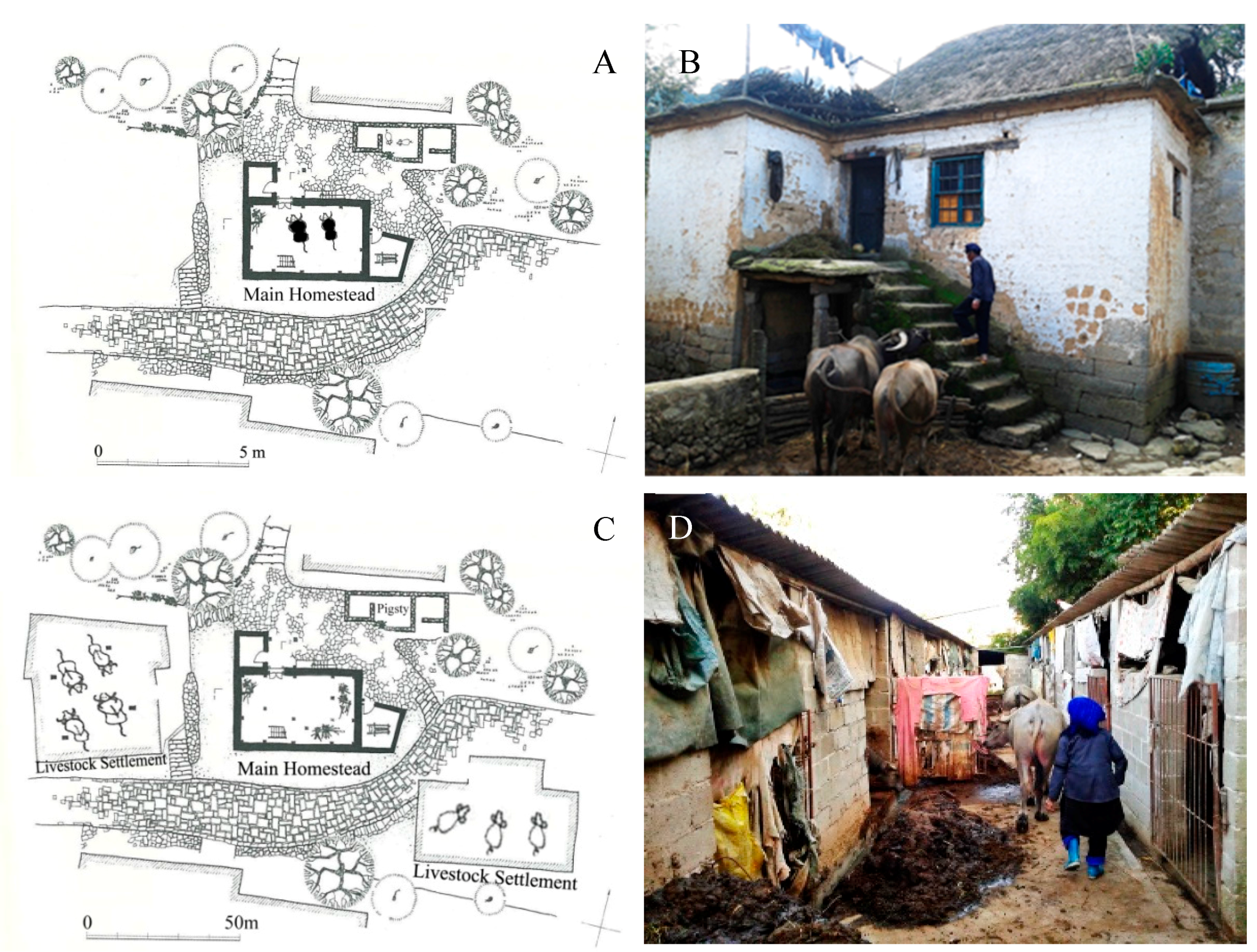
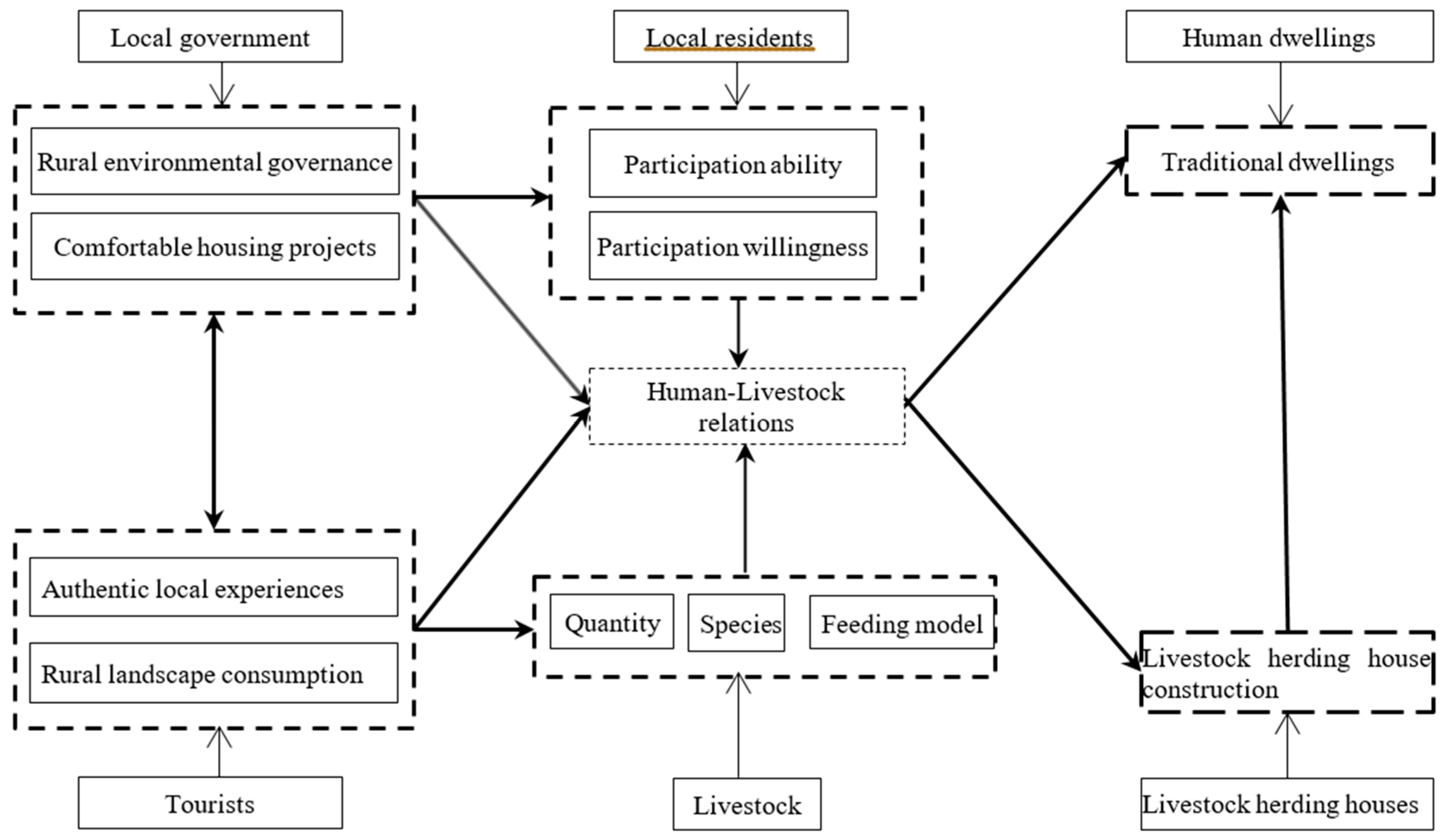
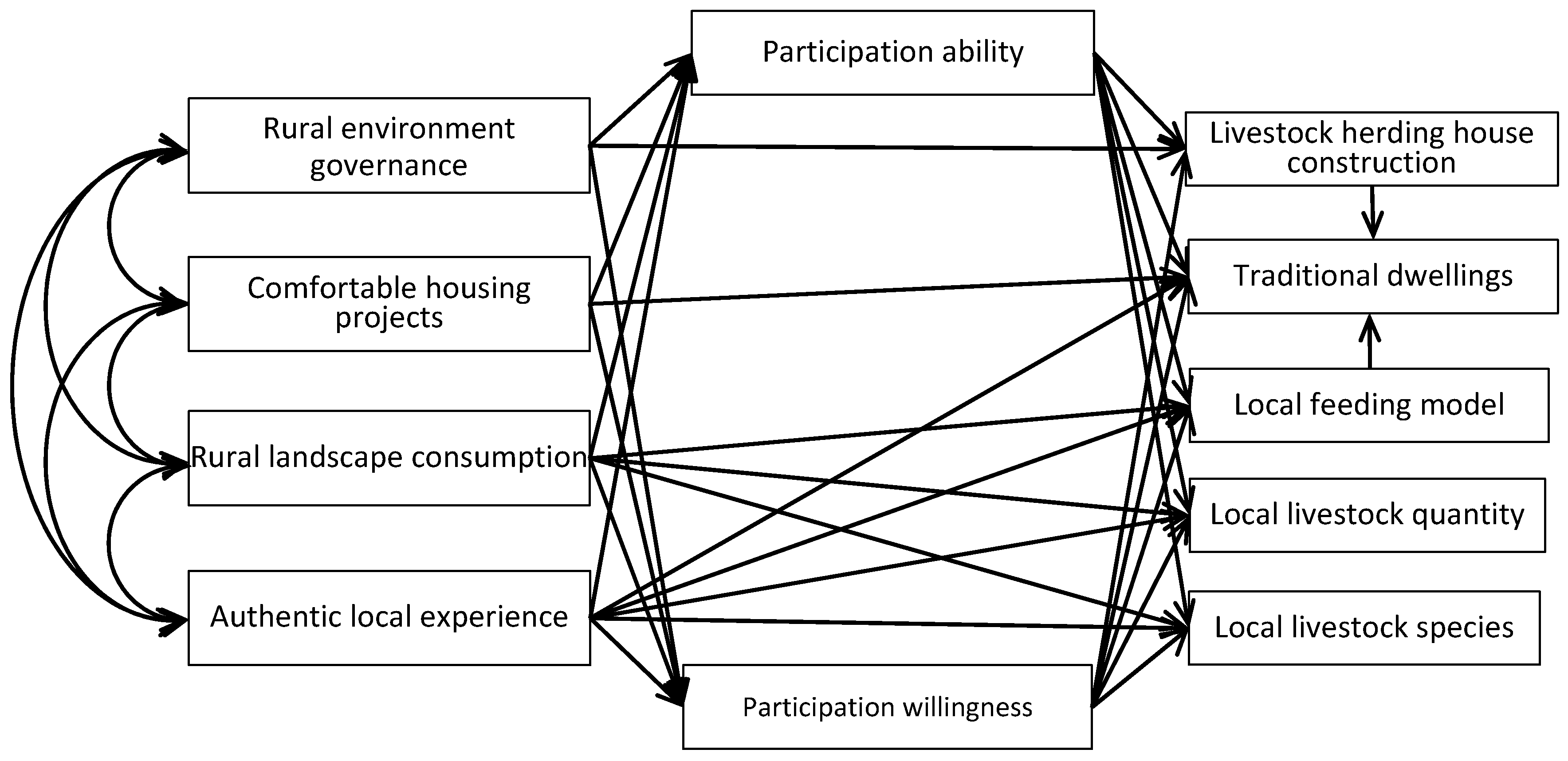
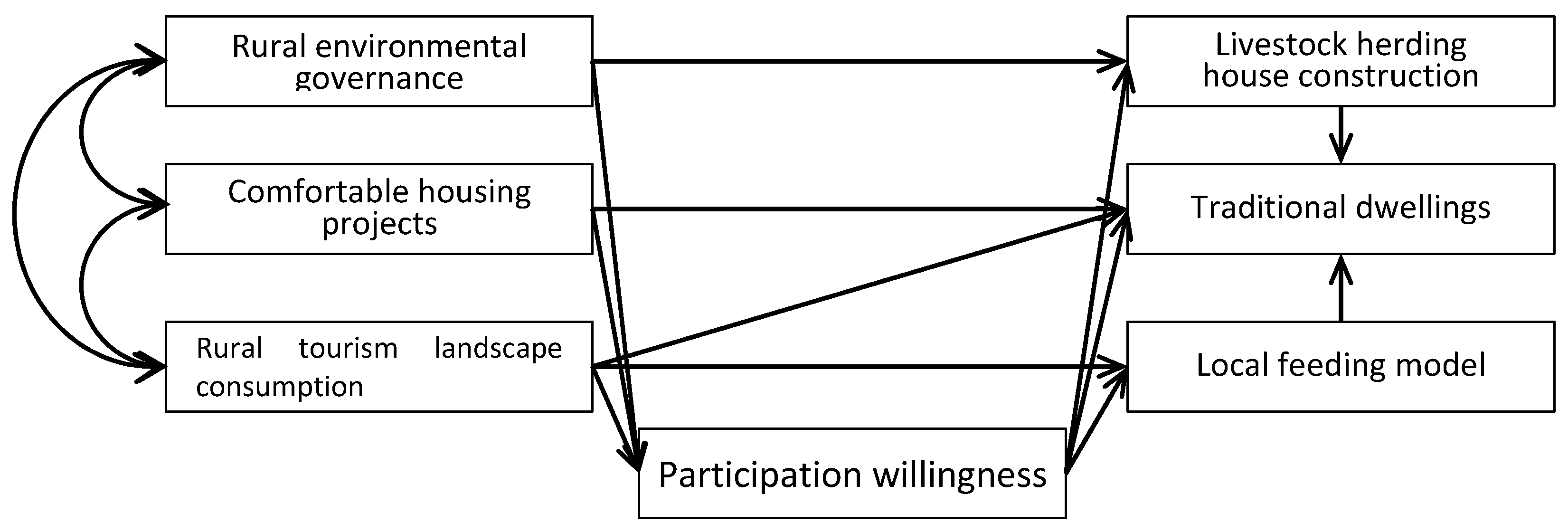

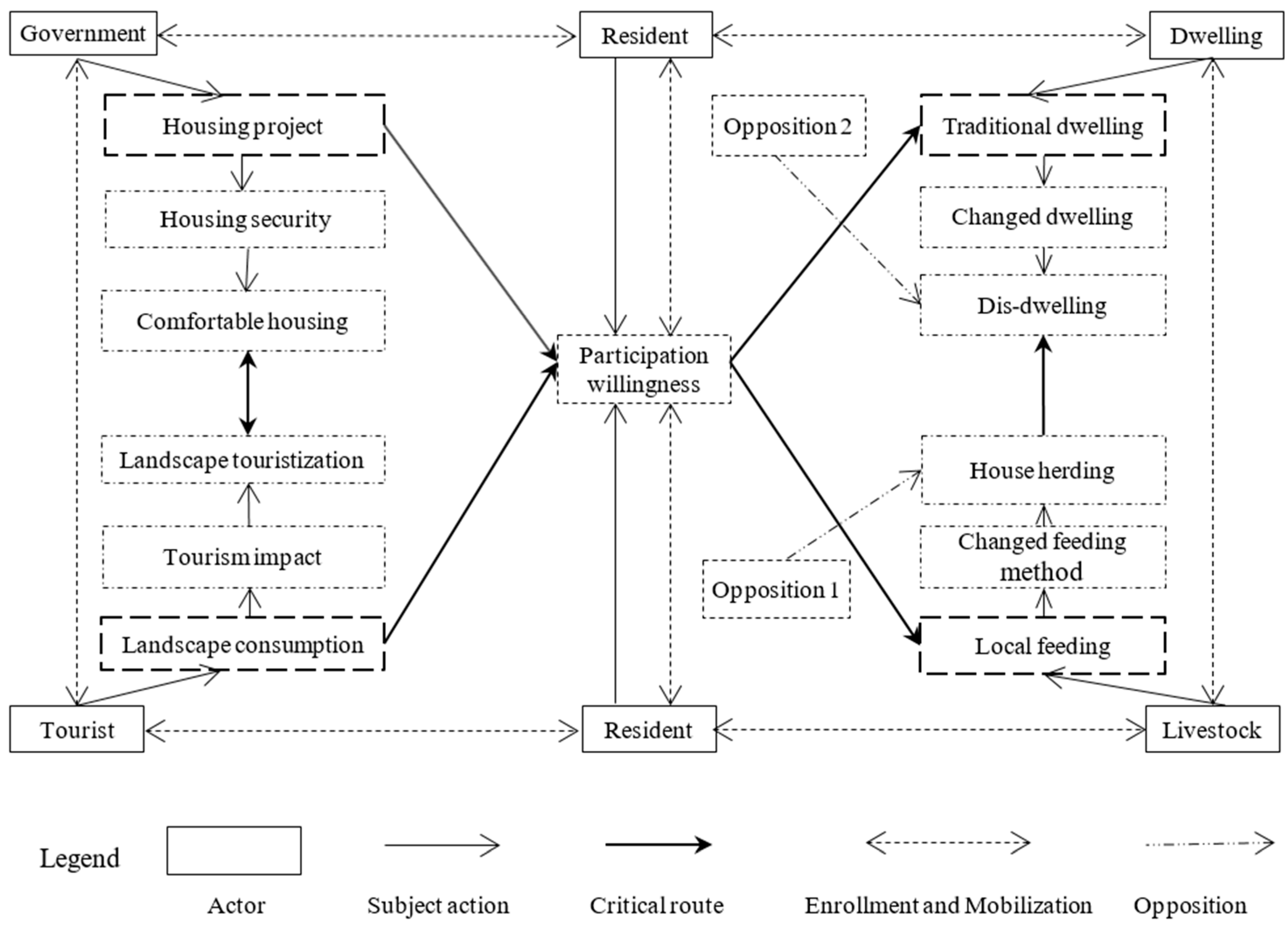
| Villages | Population | Sample | Displacement Rate |
|---|---|---|---|
| QingKou | 222 | 27 | 41%; has a concentrated livestock resettlement area; approximately 68–102 cattle can be housed in 34 cattle sheds; approximately 162–243 pigs can be placed in 81 pig sheds. |
| DaYuTang | 101 | 64 | 50%; has a concentrated livestock resettlement area; approximately 90–135 cattle can be housed in 45 cattle sheds; approximately 102–153 pigs can be placed in 51 pig sheds. |
| HuangCaoLing | 192 | 30 | 50%; no concentrated livestock resettlement area. |
| PuGaoLaoZhai | 152 | 72 | 50%; has a concentrated livestock resettlement area. No cattle sheds; approximately 40–60 pigs can be housed in 20 pig sheds. |
| NiuLuo | 57 | 39 | 50%; no concentrated livestock resettlement area. |
| DuoYiShu-1 | 96 | 24 | 52%; no concentrated livestock resettlement area. |
| DuoYiShu-2 | 106 | 42 | 50%; plans have been made for concentrated livestock resettlement areas, but they have not yet built. |
| AZheKe | 82 | 54 | 50%; no concentrated livestock resettlement area. |
| Total | 1008 | 352 | 41%. |
| Embodied Action Hypotheses | Collinearity Statistic | Logistic Statistic | Conclusion | |||
|---|---|---|---|---|---|---|
| Tolerance | VIF | B | Wald | Sig. | ||
| H1: Rural environmental governance promotes livestock displacement | 0.764 | 1.309 | 0.278 | 5.315 | 0.021 | YES |
| H2: Comfortable housing projects promote livestock displacement | 0.801 | 1.249 | 0.394 | 12.162 | 0.000 | YES |
| H3: Rural landscape consumption promotes livestock displacement | 0.775 | 1.290 | 0.219 | 4.241 | 0.039 | YES |
| H4: Authentic local experience restricts livestock displacement | 0.939 | 1.065 | −0.145 | 1.479 | 0.224 | NO |
| H5: Residents’ participation ability promotes livestock displacement | 0.793 | 1.261 | 0.114 | 0.653 | 0.419 | NO |
| H6: Residents’ participation willingness promotes livestock displacement | 0.934 | 1.071 | 0.292 | 4.645 | 0.031 | YES |
| H7: Local livestock quantity restricts livestock displacement | 0.887 | 1.127 | −0.006 | 0.002 | 0.964 | NO |
| H8: Local livestock species restricts livestock displacement | 0.860 | 1.162 | −0.173 | 2.613 | 0.106 | NO |
| H9: Local livestock feeding model restricts livestock displacement | 0.942 | 1.062 | −0.291 | 4.858 | 0.028 | YES |
| H10: The traditional dwelling restricts livestock displacement | 0.843 | 1.186 | −0.360 | 6.778 | 0.009 | YES |
| H11: Livestock herding house construction promotes livestock displacement | 0.927 | 1.078 | 0.498 | 9.369 | 0.002 | YES |
| Actor | Action Barrier | OPP | Aim |
|---|---|---|---|
| Governments | Residents’ dwelling requirements and willingness | resident’s participation willingness | Comfortable and livable housing |
| Tourists | Resident and tourist sharing and translating the rural landscape | Rural landscape Touristization | |
| Residents | The cognition, emotion and attitude of the livestock displacement | Active participation | |
| Dwellings | Residents’ habitual reliance on traditional dwelling | Dis-dwelling | |
| Livestock | Residents’ habitual reliance on local feeding model | House herding |
© 2017 by the authors. Licensee MDPI, Basel, Switzerland. This article is an open access article distributed under the terms and conditions of the Creative Commons Attribution (CC BY) license (http://creativecommons.org/licenses/by/4.0/).
Share and Cite
Tang, G.; Zhang, J.; Zhang, Y. Livestock Animal Displacement on Rural Tourism Destinations: Placing Livestock's “Pest” Role in the Background. Sustainability 2017, 9, 1307. https://doi.org/10.3390/su9081307
Tang G, Zhang J, Zhang Y. Livestock Animal Displacement on Rural Tourism Destinations: Placing Livestock's “Pest” Role in the Background. Sustainability. 2017; 9(8):1307. https://doi.org/10.3390/su9081307
Chicago/Turabian StyleTang, Guorong, Jinhe Zhang, and Yu Zhang. 2017. "Livestock Animal Displacement on Rural Tourism Destinations: Placing Livestock's “Pest” Role in the Background" Sustainability 9, no. 8: 1307. https://doi.org/10.3390/su9081307





